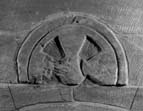Select a site alphabetically from the choices shown in the box below. Alternatively, browse sculptural examples using the Forward/Back buttons.
Chapters for this volume, along with copies of original in-text images, are available here.
Object type: Part of cross-head or disc-headed grave-marker [1]
Measurements: H. 25.5 cm (10 in); W. 38 cm (15 in); D. Built in
Stone type: Pale red (5R 6/2), fine- (0.2 mm) to coarse-grained (up to 0.6 mm), but mostly medium-grained in the range 0.4 to 0.5 mm, sub-angular to sub-rounded, clast-supported, quartz sandstone. Chester Pebble Beds Formation?, Sherwood Sandstone Group, Triassic
Plate numbers in printed volume: Ill. 382
Corpus volume reference: Vol 9 p. 146-7
(There may be more views or larger images available for this item. Click on the thumbnail image to view.)
Only one face is now visible and shows a flat (now semi-circular) border. Inside this are the three surviving wedge-shaped arms of a cross (type E6) whose extremities are linked by a narrow flat-band moulding. The arms meet in a central disc. The spandrels are left unpierced.
Appendix A item (stones dating from Saxo-Norman overlap period or of uncertain date)
Bu'lock (1959, 8) linked this head to the Chester St John group of circle-heads (see Chapter V, p. 31). It lacks, however, the distinctive 'ear-lugs' and spandrel bosses which characterise most of that set of cross-heads (Ills. 81, 83, 94, 95, 97). Closest in form among carvings related to the Chester group is the cross at Whitford in Flintshire (Nash-Williams 1950, no. 190, pl. XXXIV) though clearly this carries more decoration.
An alternative and more likely possibility is that, like Swettenham 1 above, this is part of a disc-headed grave-marker — a form which was extremely popular in the eleventh and twelfth centuries (see Bromborough 12, p. 140). The wedge-shaped arms and central disc would not be out of place in such a context, and the whole composition can be closely paralleled on Stanwick 20 in Yorkshire which raises similar problems about the original form of the monument (Lang 2001, ill. 1159).



